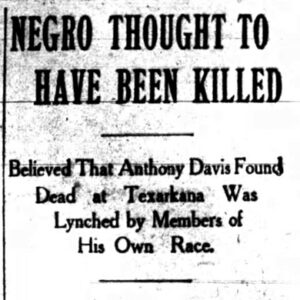calsfoundation@cals.org
Anthony Davis (Lynching of)
Anthony Davis, an African-American man, was lynched in Texarkana (Miller County) on October 9, 1906, reportedly by other local black residents. The alleged crime was the assault of a teenaged girl.
Davis was described in news reports as a “negro hack driver” (driver of a hackney carriage for hire) who was forty years old and had a wife and three children. A week before his murder, he was arrested for reportedly assaulting a “fifteen-year-old mulatto girl,” according to the Arkansas Gazette, though national newspapers placed her age at sixteen. The unnamed girl was en route from Baxter (Drew County) to Crockett, Texas, and had asked Davis to ferry her from one depot to another. However, he drove her outside the town and allegedly attempted sexual assault, though she was successful in repulsing his advances and returned to town alone, where she reported what had happened.
Davis was subsequently arrested and fined but was out on appeal by the time he was lynched. As the New York Sun reported, “Several hundred negroes got Davis, took him in his own hack to Bosse Hill, a suburb, tied a rope around his neck and strangled him to death.” The details in the Gazette are somewhat different—it reported that Davis had been lured to the site of his death, that the participants numbered from fifty to 100, and that he was likely beaten and strangled.
As Karlos K. Hill observed in his 2016 book Beyond the Rope: The Impact of Lynching on Black Culture and Memory, “Evidence suggests that black vigilantes circumvented the criminal justice system because it rarely punished crimes against blacks,” in contrast to the reason often given for cases of white vigilantism—that the justice system operated too slowly. For example, in 1892, Robert Donnelly in Lee County and Julius Mosely in Desha County were both lynched by black mobs for the alleged crime of assaulting young girls.
For additional information:
“Negro Thought to Have Been Killed.” Arkansas Gazette, October 10, 1906, p. 1.
“Negroes Lynch a Negro.” Sun (New York), October 10, 1906, p. 1.
Staff of the CALS Encyclopedia of Arkansas
 Civil Rights and Social Change
Civil Rights and Social Change Early Twentieth Century, 1901 through 1940
Early Twentieth Century, 1901 through 1940 Davis Lynching Article
Davis Lynching Article 




Comments
No comments on this entry yet.